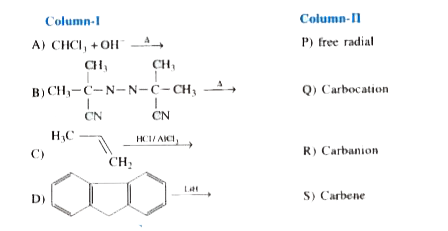The cleavage of covalent bond A−B→A⋅+B⋅ is known asSolution in Telugu
Heterolytic fission
Homolytic fission
Carbanion formation
Carbocation formation
The correct Answer is:B
Step by step video, text & image solution for The cleavage of covalent bond A-B to A^(*)+B^(*) is known as by Chemistry experts to help you in doubts & scoring excellent marks in Class 11 exams.
Topper's Solved these Questions
- BOOK - AAKASH SERIESCHAPTER - GENERAL ORGANIC CHEMISTRYEXERCISE - Objective Exercise -282videos
GENERAL ORGANIC CHEMISTRY
- BOOK - AAKASH SERIESCHAPTER - GENERAL ORGANIC CHEMISTRYEXERCISE - Practice Exercise80videos
GENERAL ORGANIC CHEMISTRY
- BOOK - AAKASH SERIESCHAPTER - GENERAL ORGANIC CHEMISTRYEXERCISE - Subjective Exercise -8120videos
GENERAL ORGANIC CHEMISTRY
- BOOK - AAKASH SERIESCHAPTER - ENVIRONMENTAL CHEMISTRYEXERCISE - EXERCISE ON PASSAGE (PASSAGE-III)5videos
ENVIRONMENTAL CHEMISTRY
- BOOK - AAKASH SERIESCHAPTER - HYDROCARBONSEXERCISE - ADDITIONAL PRACTICE SHEET ( LEVEL-II (PRACTICE SHEET (ADVANCED) (MATRIX MATCHING TYPE QUESTIONS)))5videos
HYDROCARBONS
Similar Questions
The compound containing sp sp2 and sp3 hybridised carbon atoms in 1:2:3 ratio is
01:29View SolutionThe compound CH3−CH∣CH3−CH∣CH3−CH3 contains
02:46View SolutionExplain the estimation of nitrogen of an organic compound by
(a) Dumas method and (b) Kjeldahl's method03:32View SolutionOzone layer acts as one of the most important life support system. The major cause of ozone layer destruction is believed to be the release of chlorofluorocarbon compounds. UV radiation causes the chlorofluouocarbons to dissociate : CF2Clhv−−→Cl⋅+CF2CI A highly reactive chlorine atomis responsible for the decomposition of ozone. Cl⋅+O3(g)→ClO⋅+O2(g)ClO⋅+O(g)→Cl⋅+O2(g) Free radicals of chlorine decompose ozone molecules in a chain reaction. The depletion of ozone layer leading to ozone hole has, however, been mainly observed in the stratosphere over Antarctica. Special type of cloud called polar stratospheric colouds are formed over Antarctica.These clouds (contain solid HNO3.3H2O) play an important role in ozone depletion.
ClO⋅+NO2→ClONO2
ClONO2+H2O→HOCl+HNO3
ClONO2+HCl→Cl2+HNO3
HOClhv−−→HO⋅+Cl⋅
The reactive chlorine atoms thus formed are rendered to deplete ozone layer.
The ozone layer is present in :02:42View SolutionMatch the intermediates formed in the reaction.
 02:10View Solution
02:10View SolutionHeterolytic cleavage of a covalent bond gives only,
02:57View SolutionOrganic reactions take place through the formations of reactive carbon intermediates formed by cleavage of covalent bonds. Formation of these intermediates depends upon the dissociation energies of covalent bonds. 1. Which is not the intermediate formed by cleavage of covalent bonds.
01:25View Solutionसहसंयोजक बन्ध का हेमोलिटिक विदलन मुक्त करता है :
View Solutionकिसी सहसंयोजक आबंध के विषमांगी विदलन से आप क्या समझते हैं?
View SolutionWhich is not the intermediate formed by the unsymmetrical fission cleavage of covalent bonds?
View SolutionThe process of breaking of cleavage of a covalent bond is known as ____.
View SolutionThe cleavage of covalent bond A−B→A⋅+B⋅ is known as
03:01View SolutionWhat is homolytic cleavage of covalent bond? Explain by example
02:13View Solution(i) Positive and negative ion are formed by homolytic cleavage of covalent bond.
(ii) Positive and negative ion formed by heterolytic cleavage of covalent bond.
(iii) Only homolytic cleavage is possible in C−C−Cl bond of CH3−Cl
(iv) If the heterolytic cleavage of bond then there are ionic or polar types reaction occurs in it04:26View SolutionWhat is homolytic cleavage of covalent bond? Explain by example
02:56View Solution

